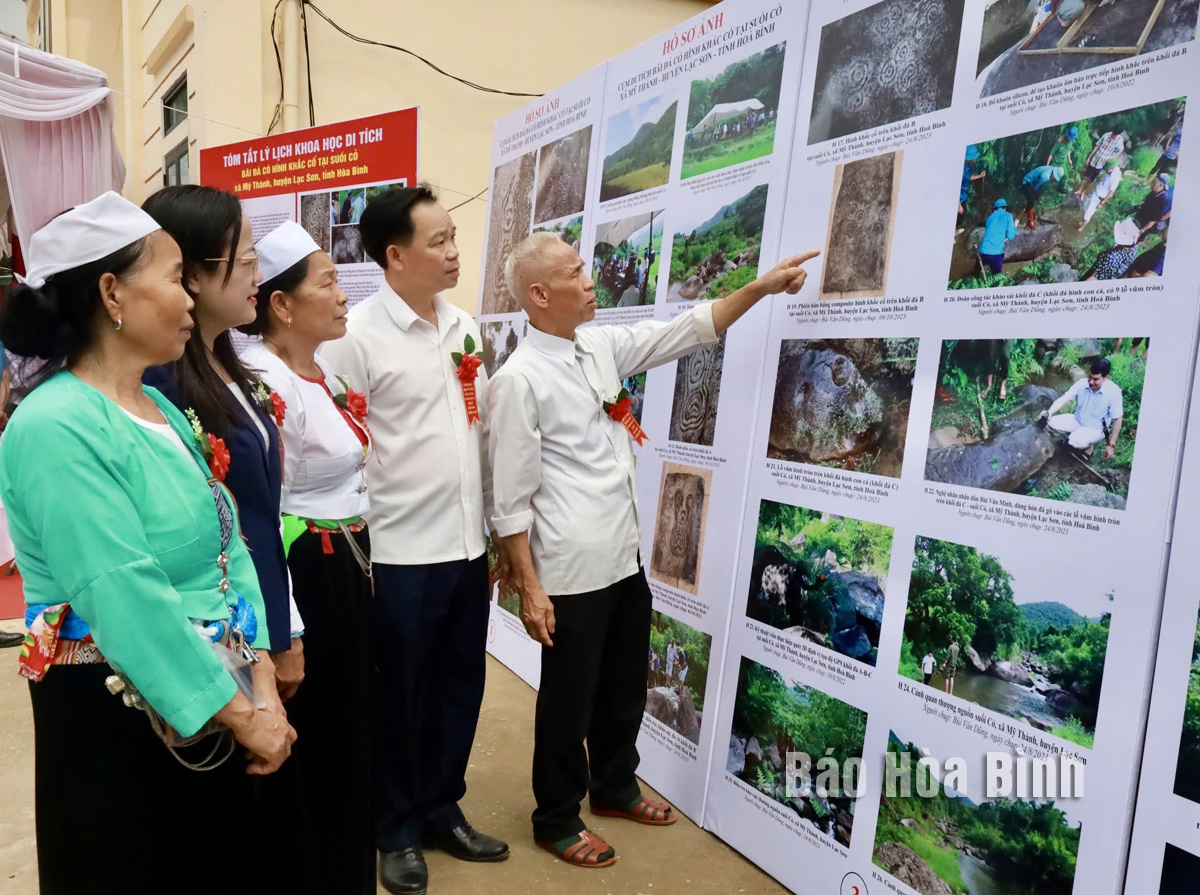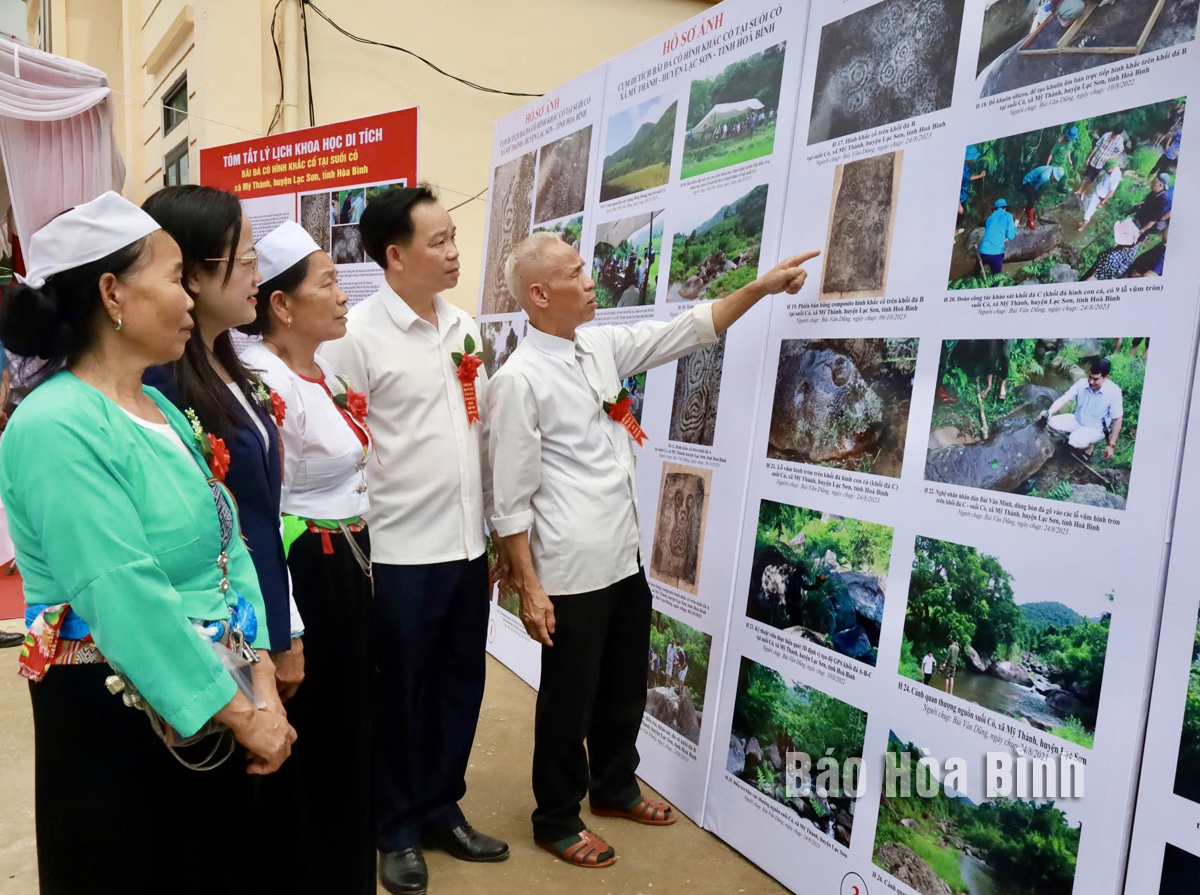
Residents of Muong Co village in My Thanh commune, Lac Son district have been delighted to learn that the ancient rock carvings at the local Co stream were officially designated a provincial-level archaeological site.
A display of
the newly designated provincial archaeological site of ancient rock carvings at
Suoi Co, exhibited at the My Thanh People's Committee.
Emphasising the significance of the site, Bui
Van Toi, Vice Chairman of the communal People’s Committee, said Muong Co is an
ancient land with a long-standing history of human settlement. The central area
of the site was once a dense forest, surrounded by rolling hills. The rock
engravings were discovered during local agricultural activities.
Co stream stretches approximately six kilometres
from Mount Voi through several hamlets – Chum, Ram, Co Giua, Vo Co, and Bui
Ruong – before emptying into Canh Tang lake. Surveys and research in the area
uncovered two engraved rock formations roughly 25 metres apart. A further
granite boulder was later identified, partially buried in the ground.
Preliminary assessments by archaeologists
suggest that the carvings date back to Vietnam’s prehistoric and early historic
periods, approximately 2,000 years ago.
Among the three, one prominent hexagonal stone
features a large carving with clearly defined incisions, including a stylised
figure with an exaggerated belly, arms raised skyward. Above each arm are
concentric circles with central dots – motifs characteristic of Dong Son bronze
culture. The second rock features four distinct sets of similar carvings, while
the third resembles a fish, marked by nine concave holes, referred to locally
as the "doong stone."
According to local tradition, annual rituals are
conducted at a small shrine located about 100 metres from the carved stones.
Dr Nguyen Viet, Director of the Centre for
Southeast Asian Prehistory, said from an archaeological perspective, these rock
carvings represent one of the rare traces of artistic and technical expression
in the prehistoric–early historic era. They indicate a significant cognitive
leap in how ancient communities in Hoa Binh’s heartland engaged with their
natural surroundings by turning natural stone surfaces into artificial spaces.
Bui Thi Dien, head of the women’s union in Ram
hamlet, added that like many here, she recognises the responsibility to
preserve the site and protect its surroundings, maintaining their natural
state.
Nguyen Thi Linh Ngoc, Deputy Director of the
provincial Department of Culture, Sports and Tourism, noted that the site holds
considerable value for research on Vietnam’sand even the world’s
prehistory. She stressed the importance of ongoing preservation and called for
expanded surveys to uncover further rock art in surrounding areas to ensure no
ancient heritage is left undocumented.
With an increasingly vibrant and widespread emulation movement aimed at building cultured residential areas and cultured families, Yen Thuy District has been making steady progress toward improving both the material and spiritual well-being of its people, while fostering a civilized, prosperous, beautiful, and progressive community.
Once lacking recreational spaces and community facilities, Residential Group 2 in Quynh Lam Ward (Hoa Binh City) has recently received attention for the construction of a new, spacious, and fully equipped cultural house. The project followed the model of state support combined with public contributions in both labor and funding.
The "All people unite to build cultural life" movement, which has been effectively integrated with Kim Boi district’s socio-economic development goals, is fostering a lively spirit of emulation across local residential areas, hamlets, villages, public agencies, and enterprises. In addition, through the initiative, traditional cultural values are being preserved and promoted, while community solidarity and mutual support in poverty reduction and economic development are being strengthened.
A working delegation of the Hoa Binh provincial People’s Committee led by its Permanent Vice Chairman Nguyen Van Toan on June 11 inspected the progress of a project to build the Mo Muong Cultural Heritage Conservation Space linked to tourism services in Hop Phong commune, Cao Phong district.
Born and growing in the heroic land of Muong Dong, Dinh Thi Kieu Dung, a resident in Bo town of Kim Boi district, in her childhood was nurtured by the sweet lullabies of her grandmother and mother. These melodies deeply imprinted on her soul, becoming an inseparable part of her love for her ethnic group's culture. For over 20 years, this love for her hometown has driven Dung to research, collect, and pass down the cultural values of the Muong people to future generations.
In the final days of May, the Ethnic Art Troupe of Hoa Binh Province organized performances to serve the people in remote, mountainous, and particularly disadvantaged areas within the province. These were not just ordinary artistic shows, but they were the meaningful journeys aimed at spreading cultural values, enhancing the spiritual life of the people and contributing to the preservation of ethnic minority cultural identities.



